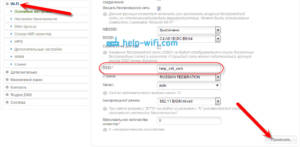- Step by step: setting up basic settings
- 1. Connect to the router
- 2. Login to the router control panel
- 3. Setting up a password and network name
- How to set up security and Internet access
- 1. Setting up Wi-Fi network protection
- 2. Restrict Internet access for certain devices
- 3. Create a guest network
- Expanding the functionality of the router
- 1. Setting up port forwarding
- 2. Setting up a VPN server
- 3. Reboot and update the router firmware
Step by step: setting up basic settings
Before you start using your TP-Link Archer router, you need to configure basic settings. This includes setting the network name (SSID) and password for accessing Wi-Fi. Step 1: Connect the router to power and your computer using Ethernet cables. Step 2: Launch your web browser and enter the address 192.168.1.1 in the address bar .Step 3: Enter the username and password to access the router settings. Typically this is admin/admin. Step 4: On the main setup page, select the 'Quick Setup' tab and click the 'Next' button. Step 5: Select the 'Wireless Router Mode' setup mode and click the 'Next' button. Step 6: Set up the network name (SSID) and password to access Wi-Fi. Click the 'Next' button. Step 7: Set your time zone and click the 'Next' button. Step 8: Check the settings and click the 'Save' button to save the changes. Now you can connect to your new Wi-Fi network using the network name and the password you specified in the settings. Basic settings have been successfully configured!
1. Connect to the router
To start setting up your TP-Link Archer router, you need to connect it to your computer or laptop using a LAN cable. One end of the cable must be inserted into any of the four LAN ports on the back of the router, and the other end into the computer’s network card.
After connecting the cable, you need to turn on the router and wait until the indicators on the front panel stop blinking, which means the download is complete.
Now you need to open the browser and enter the router's IP address in the address bar - by default it is 192.
168.
0.
1. If everything is done correctly, an authorization window will appear. Enter your username and password to access the router settings.
After successful authorization, you will be taken to the main settings page of the TP-Link Archer router, where you can continue setting up your Internet connection.
2. Login to the router control panel
To start setting up your TP-Link Archer router, you need to log into the control panel. To do this, enter the IP address of your router in the address bar of your browser. It is usually listed on the back of the device, but if you don’t find it, you can use the ipconfig command in the command line on the computer to which the router is connected.
After entering the IP address in the browser, the authorization page will open. Enter your username and password, which are indicated on the back panel of the device. If you do not find them there, then refer to the documentation for the router or enter the standard login and password: admin/admin or admin/password.
After successful authorization, you will be taken to the main page of the router control panel, where you can configure all the necessary settings, including Internet connection, Wi-Fi settings and much more.
3. Setting up a password and network name
One of the most important steps when setting up a TP-Link Archer router is setting up a password and network name. This is necessary to ensure the security of your home network and protect it from unauthorized access.
First, go to your router settings by entering the IP address of your router in the address bar of your browser. By default it is usually 192.
168.
0.
1 or 192.
168.
1.
1. Then enter the username and password that you specified when initially setting up the router.
After entering the router settings, go to the 'Wireless' section and select 'Wireless Settings'. Here you can change the name (SSID) of your network and set a password to access it.
To change the network name, simply enter the new name in the 'Wireless Network Name' field. This should usually be a name that you can easily remember.
To set a password to access your network, select the 'Wireless Security' option and select the type of security you require. We recommend using WPA2-PSK as it is the most secure type of security. Then enter the password in the 'Wireless Password' field.
Once you have made the changes, click the 'Save' button and reboot your router. Now your home network will be secure enough that only you and those to whom you give the password will be able to connect to it.
How to set up security and Internet access
Setting up security and Internet access is one of the important tasks when setting up a TP-Link Archer router. In this article, we'll look at the basic security measures you can take to protect your network from hacking and unauthorized access.
1. Changing the administrator name and password
The first step after installing the TP-Link Archer router is to change the administrator name and password. This will make access to the router settings more secure and protect them from unauthorized access.
2. Firmware update
To protect your network from vulnerabilities, you need to periodically update the firmware of your TP-Link Archer router. This will eliminate detected vulnerabilities and improve device performance.
3. Setting up a firewall
A firewall is a program that blocks unwanted traffic from the Internet. Setting up a firewall will protect your network from outside attacks and prevent data leakage.
4. Setting up content filtering
Content filtering is a feature that allows you to block access to certain sites and applications. This can be useful if there are children online who need to be protected from inappropriate content.
5. Set up Wi-Fi security
Finally, to protect your network from unauthorized access, you need to set up Wi-Fi security. TP-Link Archer has several Wi-Fi security methods, including WEP, WPA and WPA2. It is recommended to select WPA2 method as it is the most secure.
By following these simple recommendations, you can set up security and Internet access in your TP-Link Archer router and protect your network from hacking and unauthorized access.
1. Setting up Wi-Fi network protection
One of the primary tasks when setting up a router is protecting the Wi-Fi network. To do this, you need to go to the router settings, then to the 'Wireless' section and select the 'Wireless Security' tab.
Here you can select a security type, for example WPA2-PSK, and set a secret key. To increase security, it is recommended to use a complex password consisting of letters, numbers and special characters.
You can also restrict access to the Wi-Fi network based on the MAC addresses of devices. To do this, you need to enable the 'Wireless MAC Filtering' option and add the addresses of devices that are allowed to access the network.
Protecting your Wi-Fi network will help protect your data from unauthorized access and prevent possible cyber attacks.
2. Restrict Internet access for certain devices
If you want to restrict Internet access for certain devices, then the TP-Link Archer router provides this option. To do this, you need to go to the router settings and select the 'Control' item in the menu. Then select 'Access Control' and click on the 'Add New' button. In the window that appears, select the device for which you want to restrict access and set the Internet access time. You can also set restrictions on access to certain sites or ports. After you have configured the restrictions, save the settings and restart the router. Now the selected devices will not be able to access the Internet at specified time intervals or to certain sites.
3. Create a guest network
To ensure the security of your main network, you can create a separate guest network on your TP-Link Archer router. Guest network is for guests who can connect to your Wi-Fi, but should not have access to your main network and its files.
To create a guest network, log into the router's control panel and select the 'Guest Network' section. Then select 'Enable Guest Network' and configure network settings such as network name (SSID), security type and password.
You can also set limits on internet speed and time for guests. This can be useful to prevent guests from using too much bandwidth or staying connected to your network for long periods of time.
After setting up a guest network, guests will be able to connect to your Wi-Fi using the network name and password you set. They will only have access to the internet and will not be able to access your main network.
Creating a guest network on a TP-Link Archer router can be a convenient and secure way to provide Internet access to your guests.
Expanding the functionality of the router
The TP-Link Archer router has many useful features that help ensure stable and fast network operation. However, sometimes there is a need to expand the functionality of the router so that it meets the specific needs of the user.
One way to expand the functionality of the router is to install third-party firmware, for example, OpenWRT or DD-WRT. These firmwares offer additional network configuration features such as VPN, traffic monitoring, firewall management and much more.
If installing third-party firmware is not suitable, you can use the 'Guest Network' function of the TP-Link Archer router. It allows you to create a separate network for guests, which will be isolated from the main network. This will keep your network secure and protect your personal data.
Another way to expand the functionality of the router is to install additional applications on your computer or mobile device. For example, the TP-Link Tether app allows you to control your router via your smartphone or tablet, while the Netcut app helps you control access to your network.
Overall, expanding the functionality of your TP-Link Archer router can help improve the quality of your network and make it more convenient to use. Choose the method that suits your needs and start setting up!
1. Setting up port forwarding
Port forwarding allows you to redirect requests arriving on a specific router port to a device on the local network that will process them. To configure port forwarding on the TP-Link Archer router, you need to go to its settings through a browser by entering address 192.
168.
0.
1 in the address line. After entering your login and password, the main menu of the router will open. Next you need to select the 'Forwarding' tab and then 'Virtual Servers'. You can add a new port forwarding rule by clicking the 'Add New' button and filling in the required fields: external and internal ports, protocol, IP address of the device on the local network. After saving the settings, port forwarding will work.
2. Setting up a VPN server
A VPN server allows you to create a secure connection over the Internet between remote devices. To set up a VPN server on a TP-Link Archer router, you must complete the following steps:
- Log in to the router settings via the web interface using the router’s IP address and administrator credentials.
- Go to the 'VPN' section and select 'VPN server'.
- Turn on the VPN server and select the protocol for connection (PPTP, L2TP/IPSec or OpenVPN).
- Configure connection settings, including IP address and ports.
- Add users and passwords to access the VPN server.
- Save the settings and reboot the router.
- Connect to the VPN server using the client application on the remote device using the credentials created in the previous step.
Setting up a VPN server on a TP-Link Archer router will allow you to create a secure connection between remote devices, which is especially important when transferring confidential information.
3. Reboot and update the router firmware
Rebooting your router is one of the easiest ways to fix many network problems. If you have problems connecting to the internet, slow internet, or other issues, try rebooting your router.
To reboot your TP-Link Archer router, simply unplug it for a few seconds and then plug it back in.
If rebooting does not solve the problem, you may need to update your router firmware. Updating the firmware can improve your router's performance and fix bugs and security vulnerabilities.
To update the firmware of your TP-Link Archer router, follow these steps:
1. Go to the TP-Link website and find the support page for your router model.
2. Download the latest firmware for your router.
3. Go to the router’s web interface by entering its IP address in the browser.
4. Find the 'System Settings' or 'Firmware Settings' section.
5. Select the 'Update Firmware' option and select the downloaded firmware file.
6. Click 'Update' and wait for the process to complete.
After updating the firmware, the router will automatically reboot. You may need to set up your router again after updating the firmware, so be sure to save your settings before updating the firmware.
Read further:






